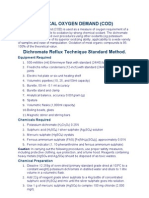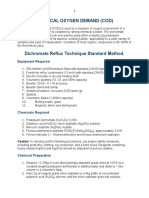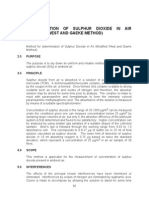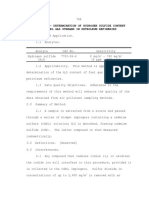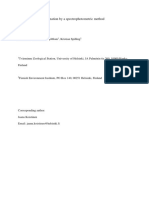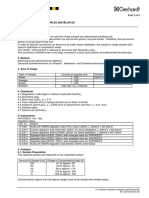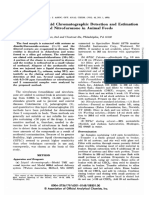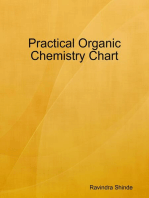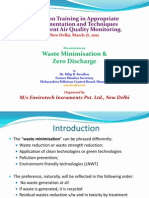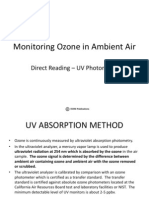Determination of Ammonia in The Atmosphere (Indophenol Method)
Determination of Ammonia in The Atmosphere (Indophenol Method)
Uploaded by
ECRDCopyright:
Determination of Ammonia in The Atmosphere (Indophenol Method)
Determination of Ammonia in The Atmosphere (Indophenol Method)
Uploaded by
ECRDOriginal Title
Copyright
Share this document
Did you find this document useful?
Is this content inappropriate?
Copyright:
Determination of Ammonia in The Atmosphere (Indophenol Method)
Determination of Ammonia in The Atmosphere (Indophenol Method)
Uploaded by
ECRDCopyright:
Determination of Ammonia in the Atmosphere
(Indophenol Method)
1. Principle of the Method
1.1 Ammonia in the atmosphere is collected by bubbling a measured volume
of air through a dilute solution of Sulfuric Acid to form ammonium
sulfate.
1.2 The ammonium sulfate formed in the sample is analyzed colorimetrically
by reaction with phenol and alkaline sodium hypochlorite to produce
indophenol, a blue dye. The reaction is accelerated by the addition of
sodium nitroprusside as catalyst.
2. Range and Sensitivity
2.1 With a sampling rate of 1 to 2 L/min a concentration range of 20 to
700µg/m3(0.025 to 1 ppm) in air may be determined with a sampling time
of 1h.
2.2 The limit of detection of the analysis is 0.2 µg NH3/mL.
3. Interferences
3.1 Ammonium compounds in suspended particulate matter will be
determined if they are not removed by prefiltration.
3.2 Prefilters may remove some gaseous ammonia. See section 7.1.1
3.3 Ferrous, chromous, and manganousions if present in mg amounts cause
positive interference in the analytical procedure because of precipitation.
Copper ions inhibit color development strongly and therefore cause
negative interference. Addition of Ethylene Diamine Tetraacetic
Acid(EDTA) prevents these effects. Nitrite and sulfite interfere if present
in 100-fold excess. Based on tests with solutions, formaldehyde causes a
negative interference of 10 to 15%. Interfering particulate matter in the air
can be removed by filteration of the air sample.
4. Precision and accuracy
4.1 Replicate samples, collected with glass prefilters and analyzed manually
showed a relative coefficient of variation of 30% in the 0.7 to 21µg/m 3(1
to 30ppb) range . This coefficient varies with concentration of atmospheric
Ammonia and decreases to 5%in the 700µg/m3 (1 ppm) range.
4.2 No accuracy data are available.
5. Apparatus
5.1 Vacuum Pump. Any vacuum pump that will maintain a vacuum of 60kPa
with an air flow of 5L/min
5.2 Flow Measuring Device. A calibrated flow meter or a critical orifice to
measure or control the air flow from 1 to 2 L/min. The flow meter should
be calibrated under conditions of use.
5.3. Absorber. A fritted bubbler, midget impinger, or other gas scrubber
designed for a flow rate of 1 to 2L/min with 10mL or more absorbing
solution is suitable for sampling.
5.4 Prefilter Holder. An open-face Teflon, Laxan, or similar filter holder
which can be connected in line before the bubbler may be used as
perobjective of monitoring
5.5 Prefilters. Organic free glass fiber filter use for air sampling for
suspended particulate matter are satisfactory.
5.6 Spectrophotometer. Capable of measuring the absorbance at 630 nm.
5.7 Glassware. Low-actinic glassware or vessels must be used for analysis.
The glassware must be rinsed with 1.2 N HCL,and washed at least 6 times
with reagent water before immediate.
6. Regents.
6.1 Purity. All chemicals should meet specifications of ACS Analytical
Regent grade.
6.2 Water. Water must meet specification of ASTM Regent water type II, and
be ammonia free.
6.3 Absorbing solution. Dilute 3.0 mL of concentrated H2SO4(18M) to 1L
with water to obtain 0.1 N H2SO4
6.4 Analytical Regents.
Sodium nitroprusside [Sodium nitrosylpentacyanoferrate(iii)] dissolve 2g
Sodium nitroprusside in 100mL of water. The solution keeps well in the
refrigerator for 2 months.
6.75 M Sodium Hydroxide: Dissolve 270g hydroxide in about 1L of
distilled water. Boil down to 600mL in order to volatilize the ammonia
contained in the reagent. Cool and fill to 1L. Store in polyethylene bottle.
Caution: this solution is extremely caustic. Prevent contact with skin or
eyes.
Sodium hypochlorite solution: Dilute 5 to 6% analytical reagent sodium
hypochlorite with distilled water to give a 0.1N solution (3.7%) Strength is
determined before dilution by iodimetric titration or colorimetry after
appropriate dilution. The solution keeps well for 2 months in a
refrigerator.
Phenol solution 45% v/v, Melt phenol by immersing a bottle containing
the material in a water bath at 60ºC, Pour 45mL(50g) in to a 100mL
warmed cylinder and fill to mark with methanol.
Buffer: Dissolve 50g of Na3,PO4, 12H2O and 74mL of 6.75M NaOH in 1
L of distilled water.
Working hypochlorite solution: Mix 30mL of 0.1 N sodium hypochlorite
and 30mL of 6.75 M Sodium hydroxide and dilute to 100mL with distilled
water. Prepare fresh daily
Working phenol solution: Mix 20mL of the 45% Phenol solution with 1
mL of 2% Sodium nitroprusside and dilute to 100mL with distilled water.
Prepare fresh every 4 hr
6.5 Ammonia Standard solution:
Ammonia stock solution. Dissolve 3.18 g of NH4CL or 3.88 g of
(NH4)2SO4 in 1 L of distilled water (1 mL equal to 1mg NH 3). Add a drop
of CHCl3 for better preservation. The solution is stable for 2 months.
Ammonia working solution: Dilute 10ml of the stock solution to 1L with
absorbing solution in a volumetric flask(1 mL equal to 10 µg NH3).
Prepare daily.
6.6 Glass Cleaning Solution. Dilute 10mL of concentrated HCL(12M) to 100 mL
with distilled water(molarity approximately 1.2M)
7. Procedure
Sample Collection: Place 10mL of absorbing solution in each bubbler for
samples and field blanks. Cap bubbler for transport. Assemble(in order)
prefilter and holder , flow meter bubbler and pump. Sample at the rate of 1
to 2 L/min for a sufficient time to obtain an adequate sample, usually 1h.
Record sampling time and flow rate. After sample collection, recap the
bubbler
Prefilters If prefilters are not used the method will determine both gaseous
ammonia and ammonium contained in particulates. At high humidity,
acid gas will promote reaction on the filter causing loss of ammonia gas
from the sample. In the absence of acid gases. Ammonia collected
momentarily on the filter during high humidity will be stripped of during
sampling with little loss.
The color may be developed in the flask 25mL, transfer contents to a
25.0 mL capacity glass graduated cylinder, being sure to blowout residual
sample from the frits if they are used. Maintain all solutions and sample at
25ºC. Add 2mL buffer. Add 5mL of working phenol solution, mix, fill to
about 22mL, then add 2.5mL of the working hypochlorite solution and
rapidly mix. Dilute to 25mL, mix, and store in the dark at 25ºC for 30 min
to develop color. Measure the absobance of the solution against a reagent
blank at 630nm, using 1cm cells.
Field Blanks. At least one bubbler of collecting solution is carried into the
field and treated in the same fashion as the actual samples except that no
air is drawn into the bubbler. It is treated in analysis as if it was a sample.
The value of the regent blank to determine either sampling glassware is
introducing appreciate contamination.
8. Calibration and standardization
Preparation of standards. Pipet 0.5,1.0 and 1.5mL of the working
standards solution into 25mL glass stoppered graduated cylinders. These
correspond to 5, 10 and 15µg of ammonia/25mL mark with absorbing
solution. Fill to the 10-mL mark with absorbing solution is also prepared.
Add reagents to each cylinder as in the procedure for analysis. Read the
absorbance of each standard against the reagent blank.
Standard Curve. Plot the absorbance as the ordinate versus the
concentration as abscissa on linear graph paper. Alternatively, determine
the slope by the method of least squares
9. Calculations
µg/m3 NH3=W/Vo
where W= µg NH3 in 25mL from standard curve.
Vo= Volume of air sample in m3 at
25º C and 101.3kPa
Vo=(F/1000) X (Ps/101.3) X (298/273+Ts)
Where F= Flow rate (L/min)
Ps=atmospheric pressure in kPa at sampling point
Ts=temperature, ºC at sampling point.
10. Effect of Storage
10.1 Sample of particulate matter may be stored indefinitely if protected from
contamination.
10.2 Changes in the precision of the method occur when storing the collectd
liquid samples during 2 days. Significantly lower values have been found on
replicates stored for several days
You might also like
- BC Live Project ReportDocument13 pagesBC Live Project ReportRishabh SinghNo ratings yet
- Osha Vi-6Document4 pagesOsha Vi-6Luis TrejoNo ratings yet
- Drug StudyDocument7 pagesDrug StudyKim GalamgamNo ratings yet
- 2008 Mondeo Owner ManualDocument286 pages2008 Mondeo Owner Manualusa_400486% (7)
- Cara SamplingDocument8 pagesCara SamplingAngga Dwi PutrantoNo ratings yet
- Chemical Oxygen Demand (Cod)Document8 pagesChemical Oxygen Demand (Cod)evreddy05100% (4)
- Methodology For AmmoniaDocument4 pagesMethodology For AmmoniaGopal MallickNo ratings yet
- Water For InjectionsDocument4 pagesWater For InjectionsAlvina Arum PuspitasariNo ratings yet
- h2s by TitrationDocument13 pagesh2s by TitrationMuhammad Amir AkhterNo ratings yet
- Iso 11262 2011Document5 pagesIso 11262 2011CRISTINA TAMASNo ratings yet
- Niosh 3500Document5 pagesNiosh 3500aguiar001No ratings yet
- Chemical Oxygen Demand (Cod) : Equipment RequiredDocument4 pagesChemical Oxygen Demand (Cod) : Equipment RequiredecotechconsultantsNo ratings yet
- CPCB - So2Document11 pagesCPCB - So2Sudipto GhoshNo ratings yet
- 4500 O3 ResidualDocument3 pages4500 O3 ResidualPenelope MeloNo ratings yet
- Niosh 6009 PDFDocument5 pagesNiosh 6009 PDFCaleb ConnerNo ratings yet
- O3Document15 pagesO3ECRDNo ratings yet
- NIOSH 7900 Arsenico As PDFDocument3 pagesNIOSH 7900 Arsenico As PDFNicolas ZeballosNo ratings yet
- Standard Analytical ProceduresDocument80 pagesStandard Analytical Proceduresengr_afsoomro3147No ratings yet
- Filter Extraction For Heavy Metals and Benzo (A) Pyrene: DR Rajendra PrasadDocument14 pagesFilter Extraction For Heavy Metals and Benzo (A) Pyrene: DR Rajendra PrasadECRDNo ratings yet
- 6015 RevDocument7 pages6015 RevAdem YildirimNo ratings yet
- Silica Determination in WaterDocument3 pagesSilica Determination in WaterAshutosh MishraNo ratings yet
- EPA 245.5 HGDocument4 pagesEPA 245.5 HGAarón CespedesNo ratings yet
- Mercury, Atomic Absorption Spectrometric, Flameless: 1. ApplicationDocument4 pagesMercury, Atomic Absorption Spectrometric, Flameless: 1. ApplicationCristian Javier Guzman DiazNo ratings yet
- Sampler: Equipped With Continuous Mixer. Manifold. Proportioning Pump II or III. Heating Bath With Distillation Coil. Distillation HeadDocument7 pagesSampler: Equipped With Continuous Mixer. Manifold. Proportioning Pump II or III. Heating Bath With Distillation Coil. Distillation HeadJane Ligia GramkowNo ratings yet
- Anal Chem 26 1949 (1954)Document7 pagesAnal Chem 26 1949 (1954)jonatanlouNo ratings yet
- Ethidium Bromide Decontamination MethodsDocument3 pagesEthidium Bromide Decontamination MethodsRaghavendra GunnaiahNo ratings yet
- Zinc, Method 8009, 02-2009, 9th EdDocument6 pagesZinc, Method 8009, 02-2009, 9th EdJe RivasNo ratings yet
- HydrazineDocument3 pagesHydrazineSylab InstrumentsNo ratings yet
- Total Dissolved Solids ProcedureDocument13 pagesTotal Dissolved Solids Procedurehemavathi jayNo ratings yet
- EPA Method 340 1Document5 pagesEPA Method 340 1Joseph Allan TolentinoNo ratings yet
- 25 2244700 Hach SdsDocument5 pages25 2244700 Hach Sdsajafri90No ratings yet
- Standard Analytical Procedures For Water AnalysisDocument80 pagesStandard Analytical Procedures For Water Analysismohamed samirNo ratings yet
- Method 11 PDFDocument28 pagesMethod 11 PDFMichael StevenNo ratings yet
- Chlorine in Unheated AirDocument9 pagesChlorine in Unheated AirSanti KertatiNo ratings yet
- Nitrogen, Ammonia, LR TNT, 0 To 2.5, Salicylate Method 10023, 02-2009, 9th EdDocument5 pagesNitrogen, Ammonia, LR TNT, 0 To 2.5, Salicylate Method 10023, 02-2009, 9th EdMohd Izdiharudin IbrahimNo ratings yet
- Nitrogen, Ammonia: Salicylate Method Method 8155 0.01 To 0.80 MG/L NH - N Powder PillowsDocument8 pagesNitrogen, Ammonia: Salicylate Method Method 8155 0.01 To 0.80 MG/L NH - N Powder PillowsFlor LopezNo ratings yet
- Total Nitrogen DeterminationDocument9 pagesTotal Nitrogen DeterminationEnvironmental Toxicology And Risk AssessmentNo ratings yet
- Nitrogen, Nitrate (Colorimetric, Brucine)Document4 pagesNitrogen, Nitrate (Colorimetric, Brucine)envirocompNo ratings yet
- Analysis of Phosphate in WaterDocument4 pagesAnalysis of Phosphate in Watermellina100% (1)
- NIOSH 8310 Ed 94 Metales en OrinaDocument5 pagesNIOSH 8310 Ed 94 Metales en OrinaMario Rodrigo Ramirez MesaNo ratings yet
- STD ChlorineDocument30 pagesSTD ChlorineMunawar HussainNo ratings yet
- DOC316.53.01002 Ed10 PDFDocument8 pagesDOC316.53.01002 Ed10 PDFMuhammad SuffyanazwanNo ratings yet
- Aluminum, Method 8012, 02-2009, 9th Ed PDFDocument6 pagesAluminum, Method 8012, 02-2009, 9th Ed PDFMuhammad SuffyanazwanNo ratings yet
- AAS - As EPA-Method-7060ADocument6 pagesAAS - As EPA-Method-7060AAhmed GwealyNo ratings yet
- Applications-Application - C.3. Nitrate in Aqueous Samples and Eluates - EnglishDocument3 pagesApplications-Application - C.3. Nitrate in Aqueous Samples and Eluates - EnglishGabriela Alejandra Benito MoralesNo ratings yet
- Furazolidone and Nitrofurazone Dengan HPLCDocument3 pagesFurazolidone and Nitrofurazone Dengan HPLCdewiNo ratings yet
- 6010 PDFDocument5 pages6010 PDFJoshua PerryNo ratings yet
- College of Medical Technology Applied Pharmacognacy - Third Year Drug Technology DepartmentDocument10 pagesCollege of Medical Technology Applied Pharmacognacy - Third Year Drug Technology DepartmentnisreenNo ratings yet
- Quantitative Estimation of Amino Acids by Ninhydrin: TheoryDocument11 pagesQuantitative Estimation of Amino Acids by Ninhydrin: TheoryNamrata KulkarniNo ratings yet
- Nessler Ammonia HACHDocument6 pagesNessler Ammonia HACHMesut GenişoğluNo ratings yet
- Method 351-1 1978Document8 pagesMethod 351-1 1978Dani Puji UtomoNo ratings yet
- 1 s2.0 S0026265X99000223 Main PDFDocument11 pages1 s2.0 S0026265X99000223 Main PDFEng MohammedNo ratings yet
- Hexanes: Chemical Names Chemical Formula Formula WeightDocument6 pagesHexanes: Chemical Names Chemical Formula Formula WeightRustika SafitriNo ratings yet
- Advanced Pharmaceutical analysisFrom EverandAdvanced Pharmaceutical analysisRating: 4.5 out of 5 stars4.5/5 (2)
- The Chemistry of Fertilisers and Manure - Including Information on the Chemical Constituents and Types of Fertilisers and ManuresFrom EverandThe Chemistry of Fertilisers and Manure - Including Information on the Chemical Constituents and Types of Fertilisers and ManuresRating: 5 out of 5 stars5/5 (1)
- Standard methods for the examination of water and sewageFrom EverandStandard methods for the examination of water and sewageNo ratings yet
- Practical Manual of Analytical ChemistryFrom EverandPractical Manual of Analytical ChemistryRating: 4.5 out of 5 stars4.5/5 (3)
- The Chemistry of Soils - Including Information on Acidity, Nitrification, Lime Requirements and Many Other Aspects of Soil ChemistryFrom EverandThe Chemistry of Soils - Including Information on Acidity, Nitrification, Lime Requirements and Many Other Aspects of Soil ChemistryRating: 4 out of 5 stars4/5 (1)
- The Chemistry of Dairy Products - A Chemical Analysis of Milk, Cream and ButterFrom EverandThe Chemistry of Dairy Products - A Chemical Analysis of Milk, Cream and ButterNo ratings yet
- Ultrasound in Food Processing: Recent AdvancesFrom EverandUltrasound in Food Processing: Recent AdvancesMar VillamielNo ratings yet
- Plant and Animal Bio-Chemistry - Including Information on Amino Acids, Proteins, Pigments and Other Chemical Constituents of Organic MatterFrom EverandPlant and Animal Bio-Chemistry - Including Information on Amino Acids, Proteins, Pigments and Other Chemical Constituents of Organic MatterNo ratings yet
- Sustainable synthesis of ciclopentene derivatives through multicomponent reactions in continuous flow regimeFrom EverandSustainable synthesis of ciclopentene derivatives through multicomponent reactions in continuous flow regimeNo ratings yet
- Analysis of NOx in Ambient AirDocument12 pagesAnalysis of NOx in Ambient AirECRDNo ratings yet
- E Learning Levels of DevelopmentDocument1 pageE Learning Levels of DevelopmentECRDNo ratings yet
- O3Document15 pagesO3ECRDNo ratings yet
- Analysis of SO2 in Ambient AirDocument20 pagesAnalysis of SO2 in Ambient AirECRDNo ratings yet
- Particulate Sampler IonDocument1 pageParticulate Sampler IonECRDNo ratings yet
- Prest WM Abridged) Envirotech 17.3Document20 pagesPrest WM Abridged) Envirotech 17.3ECRDNo ratings yet
- Analysis of Benzene: Harsh K. DixitDocument10 pagesAnalysis of Benzene: Harsh K. DixitECRDNo ratings yet
- Heavy Metals AnalysisDocument14 pagesHeavy Metals AnalysisECRDNo ratings yet
- Prest. Managing Urban Air Quality, 17.3Document17 pagesPrest. Managing Urban Air Quality, 17.3ECRDNo ratings yet
- Simple EarthDocument5 pagesSimple EarthECRDNo ratings yet
- Analysis of Benzo (A) PyreneDocument14 pagesAnalysis of Benzo (A) PyreneECRDNo ratings yet
- OzoneDocument11 pagesOzoneECRDNo ratings yet
- Apm550 MFCDocument11 pagesApm550 MFCECRDNo ratings yet
- Analysis of Benzene: Harsh K. DixitDocument10 pagesAnalysis of Benzene: Harsh K. DixitECRDNo ratings yet
- WM271 2010Document7 pagesWM271 2010ECRDNo ratings yet
- BTEXDocument7 pagesBTEXECRDNo ratings yet
- CO AnalyzerDocument8 pagesCO AnalyzerECRDNo ratings yet
- Analysis of SO2 in Ambient AirDocument20 pagesAnalysis of SO2 in Ambient AirECRDNo ratings yet
- NH3Document8 pagesNH3ECRDNo ratings yet
- Strategy of Control of Urban Air PollutionDocument8 pagesStrategy of Control of Urban Air PollutionECRDNo ratings yet
- Analysis of NOx in Ambient AirDocument12 pagesAnalysis of NOx in Ambient AirECRDNo ratings yet
- New From EIPL 2010Document14 pagesNew From EIPL 2010ECRDNo ratings yet
- Integrating Sound Level Meter: Measuring Sound Levels in Free Field ConditionsDocument19 pagesIntegrating Sound Level Meter: Measuring Sound Levels in Free Field ConditionsECRDNo ratings yet
- Analysis of Benzo (A) PyreneDocument14 pagesAnalysis of Benzo (A) PyreneECRDNo ratings yet
- Maintenance of Air Quality Instruments: Dr. Rajendra PrasadDocument9 pagesMaintenance of Air Quality Instruments: Dr. Rajendra PrasadECRDNo ratings yet
- PM10 MeasmntDocument10 pagesPM10 MeasmntECRD100% (1)
- Filter Extraction For Heavy Metals and Benzo (A) Pyrene: DR Rajendra PrasadDocument14 pagesFilter Extraction For Heavy Metals and Benzo (A) Pyrene: DR Rajendra PrasadECRDNo ratings yet
- Respirable Dust Sampler Envirotech Apm460BlDocument19 pagesRespirable Dust Sampler Envirotech Apm460BlECRDNo ratings yet
- Monitoring Ozone in Ambient Air: Direct Reading - UV PhotometryDocument11 pagesMonitoring Ozone in Ambient Air: Direct Reading - UV PhotometryECRDNo ratings yet
- Naskah PublikasiDocument13 pagesNaskah Publikasiashry09No ratings yet
- The Prophecy of St. Methodius of Patara (D. 311)Document4 pagesThe Prophecy of St. Methodius of Patara (D. 311)Apocalypse88867% (3)
- Meaning of Edu TourismDocument9 pagesMeaning of Edu Tourismclma321801No ratings yet
- Ingles Rainier 12Document19 pagesIngles Rainier 12Evelin RojasNo ratings yet
- Math FunctionDocument2 pagesMath FunctionSushant VanveNo ratings yet
- BIGTVUser GuideDocument26 pagesBIGTVUser GuideDavis Chandy100% (1)
- 2-Mechanisms of StrengtheningDocument18 pages2-Mechanisms of StrengtheningRalph Victor MalimetNo ratings yet
- A Synthesis of Ian StewartDocument6 pagesA Synthesis of Ian StewartAngel FermalanNo ratings yet
- PT Corona Dwi DayaDocument8 pagesPT Corona Dwi Dayaandi rafiansyahNo ratings yet
- HSE Report 6 July - 12 July 2023Document8 pagesHSE Report 6 July - 12 July 2023Renaldi IndraNo ratings yet
- Ramaswami 02 Yoga Sutra PDFDocument4 pagesRamaswami 02 Yoga Sutra PDFRodrigo Alonso Garrido StuardoNo ratings yet
- Daftar Produk CEUDocument1 pageDaftar Produk CEUZulfan STNo ratings yet
- Aristotle Classification of GovernmentsDocument2 pagesAristotle Classification of Governmentsjonas mwelwa100% (1)
- Writing VocabularyDocument1 pageWriting VocabularyFallsFavouriteFindsNo ratings yet
- Computer Education Franchise - Computer Institute Franchise - Computer Center FranchiseDocument24 pagesComputer Education Franchise - Computer Institute Franchise - Computer Center Franchisecomputer education franchiseNo ratings yet
- HRM2601Document5 pagesHRM2601Andre De BeerNo ratings yet
- LFNE5BSIDDocument2 pagesLFNE5BSIDOscar JoseNo ratings yet
- Accent ReductionDocument29 pagesAccent ReductionVishakha NoopurNo ratings yet
- Curriculum Vitae: Education QualificationDocument4 pagesCurriculum Vitae: Education QualificationBestun AhmedNo ratings yet
- Standard 5381Document1 pageStandard 5381atul sachanNo ratings yet
- ASME B 18.6.5M - 2000 (R2010) Metric Type IA Cross-Recessed Flat Countersunk Head Tapping Screws (Table 10)Document1 pageASME B 18.6.5M - 2000 (R2010) Metric Type IA Cross-Recessed Flat Countersunk Head Tapping Screws (Table 10)Mahmut ErdönmezNo ratings yet
- Jee (Advanced) Online Test Series: Class XIIDocument1 pageJee (Advanced) Online Test Series: Class XIINameet JainNo ratings yet
- Class 2 Nso 3 Years Sample PaperDocument9 pagesClass 2 Nso 3 Years Sample PaperUmesh75% (4)
- The 2013 New York Book Auction - Kolbe & Fanning Numismatic ...Document126 pagesThe 2013 New York Book Auction - Kolbe & Fanning Numismatic ...Gustavo MazaNo ratings yet
- Business Roles in FamiliesDocument3 pagesBusiness Roles in FamiliesDENSHNo ratings yet
- Heart TransplantDocument9 pagesHeart TransplantXierl BarreraNo ratings yet
- Poster KamasutraDocument2 pagesPoster KamasutranetcafeNo ratings yet





